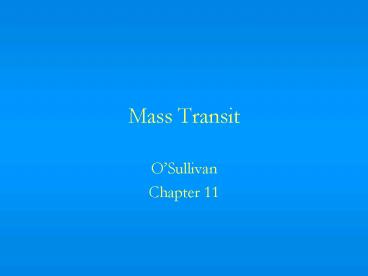Mass Transit PowerPoint PPT Presentation
1 / 16
Title: Mass Transit
1
Mass Transit
- OSullivan
- Chapter 11
2
Outline of the Chapter
- Analyze some empirical facts about public transit
in the United States - Analyze the commuters decision of travel mode
- Analyze the policy makers decision to design
public transportation
3
Transit Riders by Income Group
4
Means of Transportation to Work
5
Public Transit Ridership
6
Elasticities of Demand for Transit (OSullivan)
- Price elasticity e-0.33
- Time Elasticity
- Line-Haul Portion t-0.39
- Access Time t-0.71
- Value of Travel Time Commuters value the time
spent in transit about half their wage rate - Noncommuting Trips Noncommuting travel have
higher elasticities than commuting travel.
7
What does this all means?
- Public transit is quite inelastic increase in
fare price will increase total revenue. - Better service and higher fares may result in
higher transit. People are more sensitive to
changes in time than to changes in price - Increase of frequency and speed of buses and
finances it with higher fares. - Service improvements that decrease walking and
waiting time generate increases in ridership.
8
Analyzing the commuters decision
- 1. Choice between public transportation and
driving her own car - 2. Choice between a bus system or a rail system
9
Choice between private or public transportation
- Assume the following parameters
- In vehicle time is valued 0.10 per minute (wage
rate is 12) - Walking and waiting time at 1.5Xwage
(0.30\minute)
10
How can we get the consumer to ride the bus?
- Raise cost of car driving
- Congestion Tax
- Gasoline Tax
- Improve Service
- Lower collection and distribution tax
- Lower line-haul time
- Lower the cost of public transportation
- What if we make it free?
11
Choice between bus or rail system
- Buses
- Bus headway period of time between buses on the
bus route - Space between stops increases line-haul time,
but decreases collection and distribution time - Rail System
- Mainline versus integrated systems
- Mainline Systems Relies on other modes to
collect riders - Integrated System Entire trip in single vehicle
- Spacing between stations (tradeoff between
line-haul and collection time)
12
Policy Makers Design of a Transit System
13
Designing a transit system
- Auto System
- Cost Drivers time operating cost public
cost - Recall revenue from congestion tax equals the
cost of the optimum road - Cost of the Bus System
- Capital Cost Operating Cost Pollution Cost
Time Cost of Riders - BART and Light Rail
- Higher Collection and Distribution Cost
- Higher Capital Cost
- Higher Operating Cost
14
Subsidies of Public Transportation
15
Fare-Box Ratio The lower the FBR, the larger the
shortfall between fare revenue and operating
costs.
16
(No Transcript)

